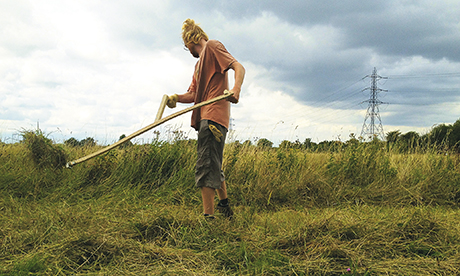‘This land is our land’: the Lammas Day ‘riots’ of August 1892

Urban pastoral: a volunteer learns the art of scything on Walthamstow Marshes. Photograph: Kathrin Böhm
The network of Working Men’s Clubs – some teetotal, some anarchist – which stretched over Leyton, Walthamstow and Homerton in the late nineteenth century, figures in the story of the Lammas Day riots, but the origins of the quarrel are found in ancient agricultural rights and the pre-Christian Celtic calendar.
The Celtic tradition divides the year into two seasons, winter, beginning at Samhain (pronounced ‘sal-wen’) on 31 October, and summer, starting at Imbolg (‘imulk’) on 1 February. Between the two, in the middle of the Celtic summer on 1 August, is Lammas Day.
Lammas signalled the shift of agricultural focus from plants to animals. It was the last day on which grass was cut for hay. Grazing could commence and the hunting season began. ‘The Glorious Twelfth’ – the first day for shooting grouse – is Lammas Day, pushed eleven days back by the UK’s transition from the Julian calendar to the Gregorian in 1752.
The right to cut hay and graze animals on certain fields extended to all parishioners, rich or poor. Such fields were known as Lammas land. Their use belonged to everyone.
So when, in 1892, the East London Water Company laid a railway track across Leyton Marsh to transport coal to their pumping engines on what is now the Clancy Docwra site, it angered a great number of people.
The Vestry Council’s Lammas Lands Committee, whose members were Liberal or Tory gentlemen, ordered the water company to take up the rails, and when the order went unheeded, took matters into their own hands.
Four gentlemen agreed to take responsibility for the action, hoping to encourage the masses to join in. It worked: on the Bank Holiday Monday, 3,500 people marched on the Marsh, and took up the rails themselves.
Barbados-born Chris Humphries, a Justice of the Peace and County Councillor in Essex, was to the fore. He was charged, along with eight others, four of whom were prosecuted under the Malicious Damages (Railways) Act of 1861.
The East London Water Company decided it wasn’t going to be beaten easily. The Tuesday after the tracks were removed, they sent out workers to re-lay them. The following Saturday another meeting was called at the Antelope pub, still standing today at the top of Marsh Lane.
The atmosphere was different this time. The Lammas Lands Committee – midway through their court case with the water company – was opposed to further action. They publicly broke with the wreckers, leaving them to be led by Aubrey Barker, founder of the Walthamstow Working Men’s Club. Once again, they marched down to the Marsh and took up the rails. The water company, again, re-laid them on the Monday.
This was war. On Tuesday, 1,500 people descended on the tracks, including a large party from Leyton and four Working Men’s Clubs in Homerton. They tore up the rails and knocked down the fences the water company had erected to protect them.
The water company had the rails re-laid yet again on the Wednesday.
Without the Homerton contingent, that might have been it. But on the Saturday, led by a man known only as ‘the Village Blacksmith’, the clubs gathered their full strength to march on the tracks, pulling them out of the ground and throwing them all over the field.
This was the final blow. The water company gave up. The tracks vanished from the landscape.
In August 1893, a meeting was called to celebrate the previous year’s ‘Great Riot’. One speaker suggested the land should be given over to the local people for purposes other than grazing, as it was now primarily used for playing cricket. This was the first proposal for what became of the Lammas Rights: in 1904, they were commuted for Access Right — Land is vested with local authorities but is to be kept open for the whole community to use.
